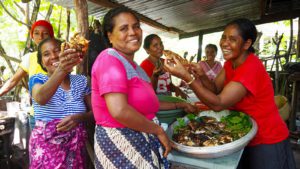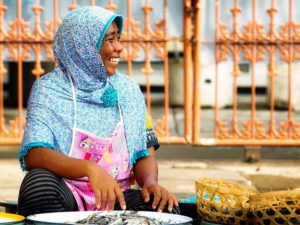In mid-2022, collaborators will launch the second edition of Illuminating Hidden Harvests (IHH), a seminal report that quantifies and characterizes small-scale fisheries (SSF) globally. A team of gender experts was pivotal in applying a gender lens to the study design and methodology to ensure that contributions to the sector by both women and men are represented in the report. Our Shared Seas spoke with Dr. Kafayat Fakoya, a gender advisor for IHH, to discuss how and why gender was intentionally integrated into the global report from the outset.
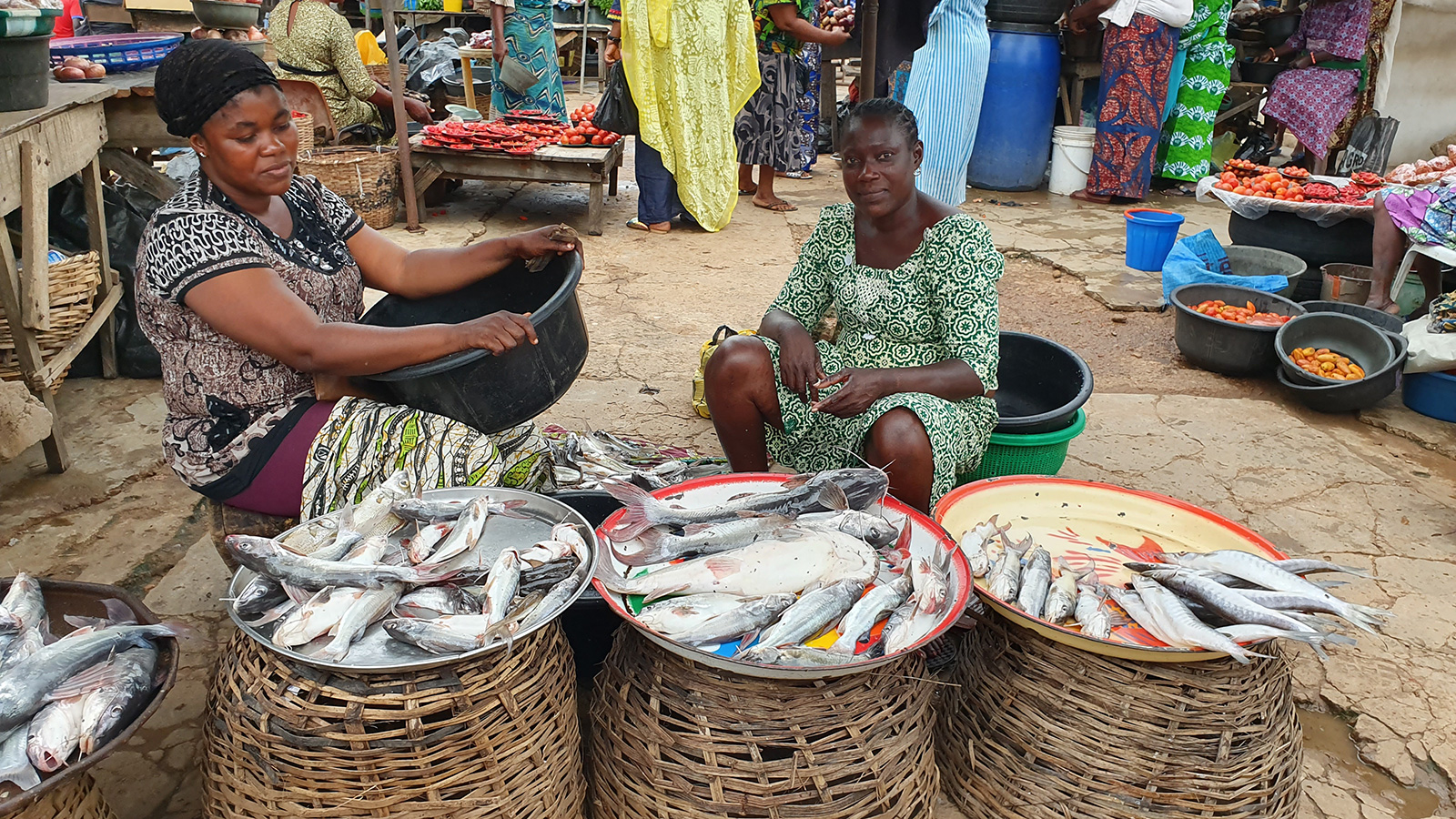
Marketing fish in a local market in Lagos, Nigeria. Photo by Nhuong Tran (via WorldFish / Flickr)
Dr. Kafayat Fakoya is an associate professor at Lagos State University in Nigeria. She was the gender advisor and a contributing author for the Illuminating Hidden Harvests Nigeria case study. Dr. Fakoya—who has worked in small-scale fisheries for about 10 years—has a particular interest in gender, governance, livelihoods, and well-being.
You served as a gender advisor for the forthcoming Illuminating Hidden Harvests (IHH) report. What did this role entail, and why did the study explicitly include gender dimensions in the methodological design?
The role entailed unveiling roles, responsibilities, contributions, benefits, and costs of men and women participating in small-scale fisheries (SSF). Gender dimensions were included to highlight and fully count gender dimensions in fisheries. The inclusion helped to provide clarity and evidence on the different roles and extent of participation played by women in sharp contrast to men in SSFs.
This lens proved to be very important because it revealed social norms and gendered power relations that influence gender roles and the extent of participation in SSFs. These findings brought to the fore a broader picture of gender-related constraints and barriers, benefits, contributions and costs, which, in turn, opens opportunities for gender-responsive actions, plans, and policies that would help improve food security, livelihoods, and well-being and provide sustainable fish production and supply from SSFs.
Can you share an overview of how gender components factored into the Illuminating Hidden Harvests report? What type of content or findings will the report feature on gender in fisheries, and what is new about this work as compared to past reports or studies?
Data was missing on many gender components of small-scale fisheries in Nigeria. But the probing questions provided in the report’s gender themes succeeded in eliciting information and data on how gender relates to environmental, governance, social, and economic dimensions.
The forthcoming report will highlight robust economic valuations and contributions of SSFs to national and global economies and particularly provide information on the economic contributions of women’s labor in many fisheries activities, as compared to the sparse information in previous studies.
Women in SSFs are generally multi-tasking and undertake many fisheries-related activities in their homes or vicinity of their households, such that nuances between productive and reproductive activities are almost inseparable or hidden. A significant portion of women’s domestic activities that contribute to the sustenance and wellbeing of households are overlooked. The consequence is that women’s roles and labor may not be included or given the priority they deserve in formal economic assessments of fisheries.
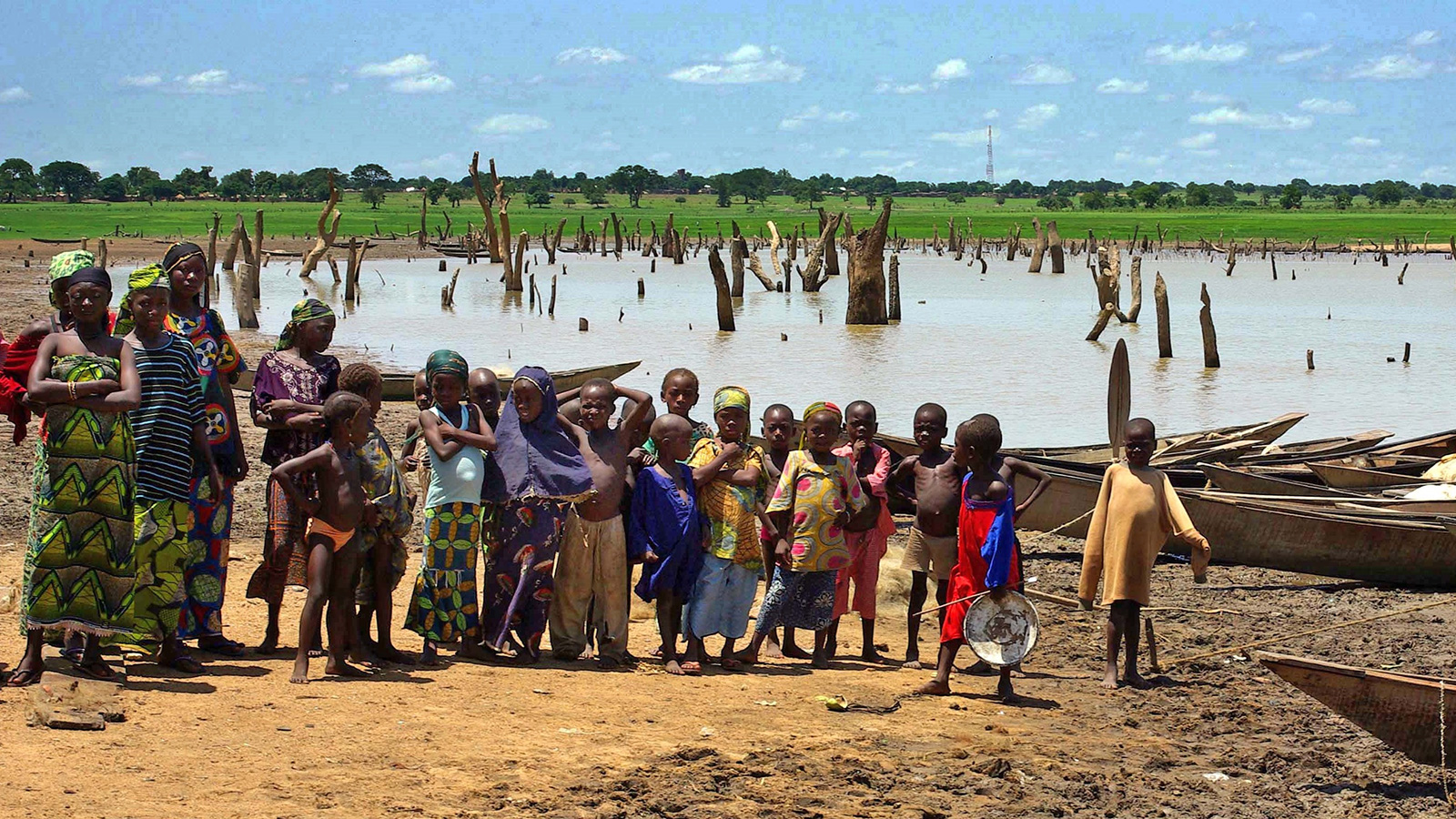
Inland fishing on Lake Kainji, northern Nigeria. Photo by David Mills (via WorldFish / Flickr)
Unlike the act of fishing—which tends to be culturally accepted as a male profession and forms the basis of determining the economic value of SSFs—women’s contributions in the value chain are often overlooked or under-estimated in national economic or statistical data. Examples of missing data include but are not restricted to data or information on gleaning or fishing by women and children to feed the household, repairing nets, and off-loading catch for their husbands who do the fishing. Other nodes of the value chain in the pre-harvest subsector are seldom evaluated for their economic contributions and the paucity of economic and employment data in this subsector may be applicable to both genders, depending on local context.
Unlike the act of fishing—which tends to be culturally accepted as a male profession and forms the basis of determining the economic value of SSFs—women’s contributions in the value chain are often overlooked or under-estimated in national economic or statistical data. Examples of missing data include but are not restricted to data or information on gleaning or fishing by women and children to feed the household, repairing nets, and off-loading catch for their husbands who do the fishing.
You also contributed to a Nigeria case study for the Illuminating Hidden Harvests report. Can you describe what this process looked like and how gender considerations played a role in your research?
The process was holistic and interdisciplinary in terms of the research methodology. We utilized a mixed methods approach to collect secondary data and generated qualitative data from in-depth interviews and consultations with experts, key informants including fishers and fisherfolks, and government officials. We were able to elicit information and synthesize knowledge on the present status and extrapolate to ensure that substantial areas were covered as much as possible.
The probing questions in the Illuminating Hidden Harvests gender theme specifically addressed women’s roles and responsibilities in SSFs, helping us to move away from gender-blind towards gender-aware research. Our hope is to eventually transition to gender-responsive research.
The probing questions in the Illuminating Hidden Harvests gender theme specifically addressed women’s roles and responsibilities in SSFs, helping us to move away from gender-blind towards gender-aware research. Our hope is to eventually transition to gender-responsive research.
In many fisheries data systems around the world, there is incomplete data on the roles and contributions of women to small-scale fisheries. From your perspective, what are the consequences of missing sex-disaggregated data?
The consequences of missing or disregarding to gender data are barriers and constraints to achieving Sustainable Development Goals (SDGs), from the local to global levels. When relevant data is missing, all SDGs are negatively impacted because of the inter-dependency and inter-relatedness of the SDGs.
With the growing awareness of the importance of gender or sex-disaggregated data (quantitative and qualitative), there is an opportunity to fill in gender data gaps to help shape policies and more sound decision-making. The ability to achieve equitable representation yields many benefits, such as enhanced compliance to regulations in fisheries management, equitable distribution of resources, and other matters related to poverty reduction. On the other hand, the paucity of gender data in SSFs will continue to undermine efforts to attain SDGs at all levels and curtail contributions to national Gross Domestic Product (GDP), thus limiting growth and development potentials in the sector.
The consequences of missing or disregarding to gender data are barriers and constraints to achieving Sustainable Development Goals (SDGs), from the local to global levels. When relevant data is missing, all SDGs are negatively impacted because of the inter-dependency and inter-relatedness of the SDGs.
How do women’s contributions to small-scale fisheries relate to goals for supporting food security and ending hunger? Do women fishers play an overlooked role when it comes to food security?
The contributions of women in small-scale fisheries have strong linkages to support food security and ending hunger; this is most obvious in fishing communities. In many places and contexts, social norms and culture dictate that women in small-scale fisheries are the backbone in fishing households saddled with the primary responsibility to maintain a sustainable supply of food for their families, both in and out of the fishing seasons.
Rather than women fishers, I think I prefer to call them harvesters, a term inclusive of women who glean and play an overlooked role in food security. In the fisheries statistical records of many countries, fishers are given male identities and catch attributed to fishers and fishermen and seldom, if at all attributed or documented on the basis of gender. As a result, women’s contributions are overshadowed, and their overlooked status is reinforced by the extant traditionally and culturally acceptable descriptions of fishing conceived as an exclusively male sphere.
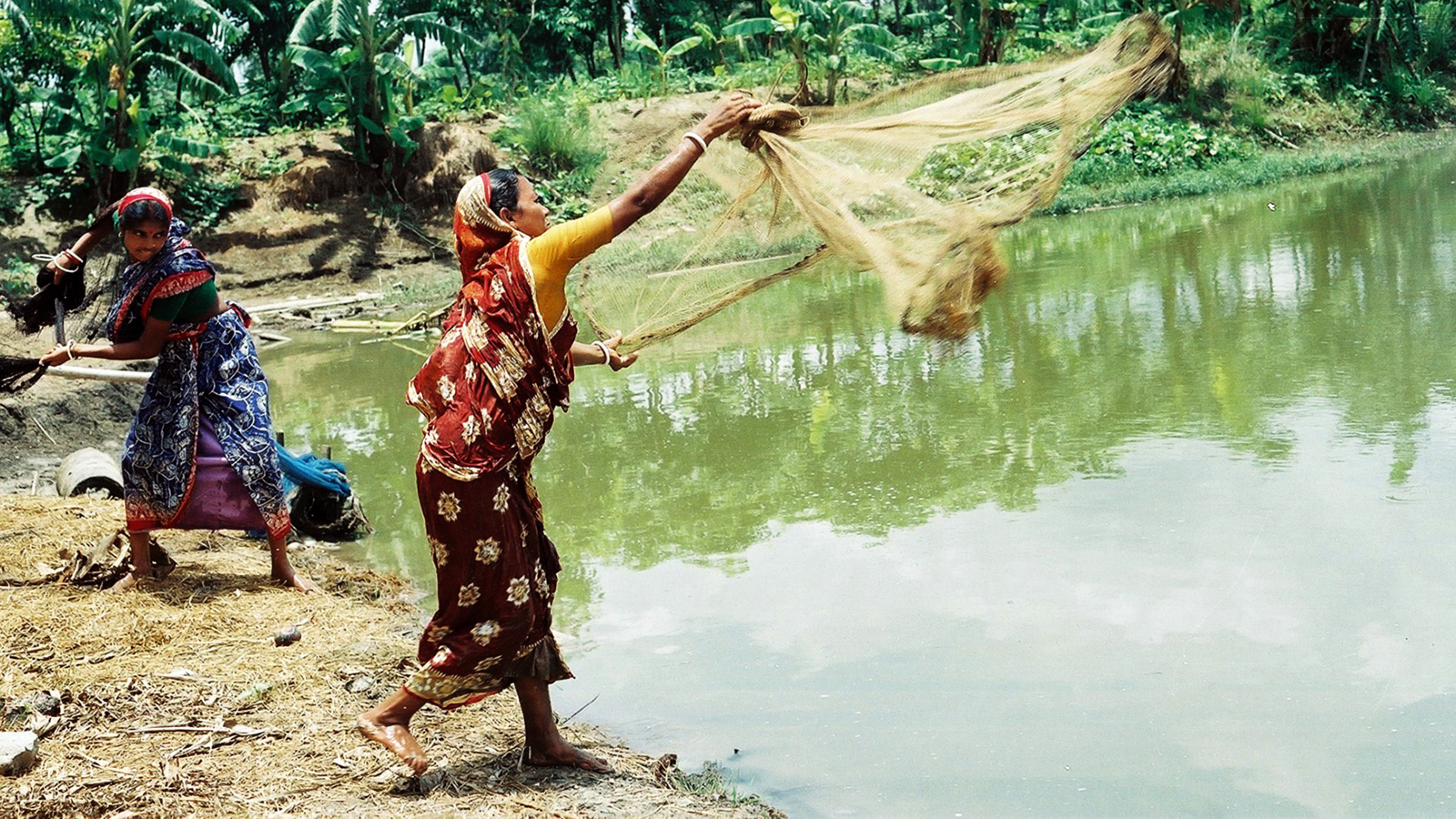
Women in fisheries, Bangladesh. Photo by CBFM-Fem Com Bangladesh (via WordlFish / Flickr)
Catch from SSFs supplies a substantial portion to domestic production and consumption in many low- and middle-income countries. In the case of Nigeria, SSFs provide 70 percent domestic fish production and account for about 50 percent of the total fish consumption. Analysis of gendered contributions to food security in fishing households helps to highlight women’s contributions. While both men and women are involved in fisheries at different level of engagements, women’s catch or harvest (at times involving their children) may not be included or recorded in official catch and effort data because it may be viewed as harvest for subsistence.
In the context of some developing countries, exclusive subsistence fisheries do not exist because part of the catch or harvest is also sold to generate income which is used to purchase other staple foods and achieve household food security. The works of Dr. Danika Kleiber and Dr. Sarah Harper provide concrete evidence that women’s contributions do count in fishing and indeed, the objective of their fishing is beyond subsistence and food security.
The contributions of women in small-scale fisheries have strong linkages to support food security and ending hunger. In many places and contexts, social norms and culture dictate that women in small-scale fisheries are the backbone in fishing households saddled with the primary responsibility to maintain a sustainable supply of food for their families, both in and out of the fishing seasons.
Looking forward, how would you like to see findings from the IHH report inform policy and programs across various local to global levels?
I would like to see the IHH study influence present and future SSF research priorities and support evidence-based policies, action plans, and programs at global, regional, national, and local levels.
What are the most promising solutions for creating more equitable and inclusive systems for women to participate in fisheries production and management?
In my opinion, the most promising solutions are:
- Build capacity in gender-responsive research and include gender experts in fisheries management and policy;
- Allocate funds to gender research and training human resources;
- Conduct gender audits to determine capacity building needs;
- Collect quantitative and qualitative gender data adapted to help understand contextual gender disparities, social norms, and gendered power relations;
- Integrate gender equality and human rights in monitoring and evaluation framework; and
- Develop gender capacity indicators and targets to reduce gender gaps in SSFs value chains and, monitoring and evaluation frameworks.

